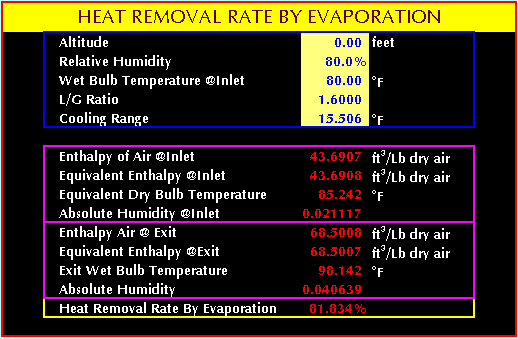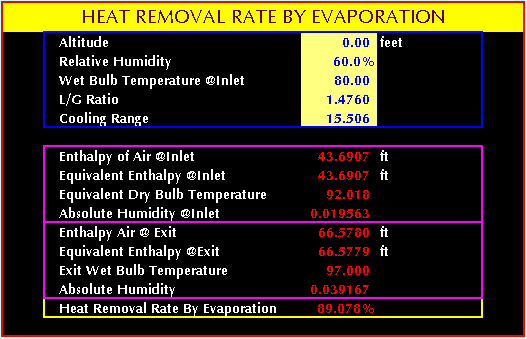|
When water is cooled in a direct contact cooling tower
of air and water, some of the heat is removed by the
sensible heat of air in contact with the water. Most
of the heat is removed by evaporation of a portion of
the circulating water. This mass transfer of water occurs
normally from the water stream to the air stream. However,
this transfer will be in the opposite direction if the
entering water temperature is lower than the entering
air wet bulb temperature. In the usual cooling tower
operation the water evaporation rate is essentially
fixed by the rate of removal of sensible heat from the
water, and the evaporation loss can be roughly estimated
as 0.1% of the circulating water flow for each degree
F of cooling range.
Sensible heat transfer involves
an increase in the dry bulb temperature of mixture but
evaporation heat transfer involves a change in the humidity
ratio of the mixture. Thus, a sensible heat transfer
from water to air inside a cooling tower involves a
horizontal change on the psychrometric chart while evaporative
transfer involves a vertical movement as is illustrated
in psychrometric curve. Sensible heat transfer refers
to heat transferred by virtue of a temperature difference
between the water and air. Evaporative heat removal
refers to the energy removal from the water as latent
heat of evaporation; this heat removal is the result
of the evaporation of water into air during the direct-contact
cooling process. In a wet cooling tower, where the temperature
of water is greater than the ambient wet bulb temperature,
the air humidity always increases as the air passes
through the tower. Sensible heat transfer may be either
positive or negative. When the temperature is less than
the ambient dry bulb temperature, the sensible heat
transfer may be negative and the air dry bulb temperature
will be lowered as the air passes through the tower;
under these circumstance, the air as well as the water
is cooled by evaporative transfer in the cooling tower.
In normal cooling tower operation
the amount of heat removal by the evaporation is about
60 to 95% to the total heat, and it varies upon the
cooling range, air flow rate, relative humidity, and
dry bulb temperature, etc.
Example 12-1.
Determine the evaporation loss in a percentage for the
previous example 6-1.
(Solution)
Evaporation Loss Rate = (Absolute Humidity @ Tower Exit
- Absolute Humidity @ Tower Inlet) x 1/(L/G) x 100
Absolute Humidity @ Tower
Exit (97oF WBT) = 0.039166
Absolute Humidity @ Tower Inlet (85.24oF
DBT & 80% RH )= 0.021117
Evaporation Loss Rate = (0.039166 - 0.021117) x 1 /
1.4760 x 100 = 1.22%

Download
the example file (exe12_1.zip)
The above calculation
is based on a value of L/G , which was obtained from
a result of ignoring the term of evaporation loss in
the heat balance. In case of considering the loss of
water due to the evaporation, L/G must be computed again
as follows;
L2/G = {(ha2
- ha1) - (tw1 -32) x (w2
- w1)} / (tw2 - tw1) (tw2
- tw1 = Actual Range)
Air Enthalpy at Exit (97o F) = 66.5773 Btu/lb
Air Enthalpy at Inlet (80oF) = 43.6907 Btu/lb
Then, L2/G = {(66.5773 - 43.6907) - (89 -
32) x (0.039166 - 0.021117)} / 15.507 = 1.4096
Evaporation Loss Rate = (Absolute Humidity @ Tower Exit
- Absolute Humidity @ Tower Inlet) x 1/ (L2/G)
x 100 = 1.28%

Download
the example file (exe12_1A.zip)
Example 12-2.
Determine the heat removal in the percentage by the
evaporation for the example 6-1.
(Solution)
Evaporation Rate = (w2 - w1) x
Latent Heat of Water / (Enthalpy @ Exit - Enthalpy @
Inlet)
Latent Heat of Water: About 1,040 BTU/Lb of Water
(Note: For each pound of water that a cooling tower
evaporates, it removes somewhere near 1,040 BTU from
water. Evaporative heat removal refers to the energy
removal from water as latent heat of evaporation. This
heat removal is the result of the evaporation of water
into air stream during the direct contact cooling process.)
Evaporation Rate = (0.039166
- 0.021117) x 1040 / (66.5773 - 43.6907) x 100 (%) =
82.02%
Example 12-3.
Determine the rate of heat removal by to the evaporation
under the assumption that the L/G ratio was changed
to 1.600 for the initial conditions of example 6-1.
(Solution)
First, let's calculate the enthalpy of exit air.
Enthalpy of Exit Air = Enthalpy
of Inlet Air + L/G x Actual Range = 43.6907 + 1.6 x
15.506
= 68.5019 BTU/lb
Exit Air Temperature = 98.14oF
img_01/
Download
the example file (exe12_3.zip)
Absolute Humidity @ Tower
Exit = 0.040639
Absolute Humidity @ Tower Inlet = 0.021117
Therefore, evaporation rate = (0.040639 - 0.021117)
x 1040 / (68.5008 - 43.6907) x 100 (%) = 81.83%

Download
the example file (exe12_3A.zip)
Through above two examples
the heat removal rate by the evaporation varies with
the ratio of water and air mass flow rate. Under the
same water flow rate, the higher L/G the smaller evaporation
rate.
Example 12-4.
Determine the rate of heat removal due to the evaporation
under the assumption that RH was changed to 60% from
80% for the example 6-1.
(Solution)
First, calculate the dry bulb temperature of inlet air
and find the humidity ratio with the dry bulb temperature
& relative humidity.
Absolute Humidity @ Tower
Exit = 0.039167
Absolute Humidity @ Tower Inlet = 0.019563
Therefore, evaporation rate = (0.039167 - 0.019563)
x 1040 / (66.5780 - 43.6907) x 100 (%) = 89.08%

Download
the example file (exe12_4.zip)
Note that the evaporation
rate of heat removal is being highly effected by the
change of relative humidity. Sensible heat transfer
involves an increase in the dry bulb temperature of
the mixture but evaporative heat transfer involves a
change in the humidity ratio of the mixture. Therefore,
a sensible heat transfer from water to air inside a
cooling tower involves a horizontal change on the psychometric
chart while evaporative transfer involves a vertical
movement on the psychometric chart. In a wet cooling
tower, which the inlet water temperature is greater
than the ambient wet bulb temperature, the air humidity
always increase as the air passes through the tower.
However, Sensible heat transfer may be either positive
or negative. When the inlet water temperature is less
than the ambient air dry bulb temperature, the sensible
heat transfer may be negative and air dry bulb temperature
will be lowered as the air passes through the tower.
Under these circumstances, the air as well as the water
is cooled by evaporative transfer in the cooling tower.
|